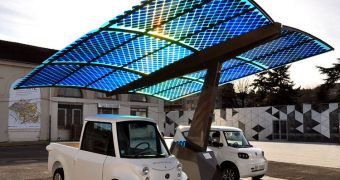A group of Spanish researchers from the Universitat Jaume I announce the development of a new type of photovoltaic devices, which rely on a combination of graphene and titanium dioxide to convert sunlight into electricity. The approach is more efficient than other chemical combinations, experts say.
Graphene was first considered as a potential replacement material for indium tin oxide (ITO) in regular solar cells a few years ago, but the Spanish team took a more drastic approach, creating graphene-based photovoltaics from scratch.
The two materials work well together, but their interactions are mediated by a species of calcium titanium oxide mineral called perovskite. This material was first discovered in 1839, in Russia's Ural Mountains, by expert Gustav Rose. Perovskite is named for Lev Perovski, a famous mineralogist.
Graphene was considered for such applications due to its amazing physical and chemical properties. The material was first obtained by researchers at the University of Manchester, in the UK, back in 2004, and has made the subject of nearly 4,000 research papers over the past decade.
It boasts a hexagonal, chicken wire-like structure, and is made up entirely out of carbon atoms. Graphene sheets are just a single atom thick, and many researchers think of it as a 2D material that can be rolled up to create carbon nanotubes.
The reason why researchers are interested in using graphene for photovoltaic devices is that the material can be fashioned into the type of transparent electrodes used in organic solar cells.
The material was also used in the conversion and conduction layers of photovoltaic cells for the first time last year, but a team including scientists in Spain, at the Max Planck Institute for Polymer Research, in Germany, and the Massachusetts Institute of Technology (MIT), in Cambridge.
The new study takes last year's research one step forward, by using a graphene/titanium dioxide combo for light conversion, and perovskite for sunlight absorption, IEEE Spectrum reports.
A paper published in the latest issue of the journal Nano Letters, entitled Low-Temperature Processed Electron Collection Layers of Graphene/TiO2 Nanocomposites in Thin Film Perovskite Solar Cells, describes how these materials work together in greater detail.

 14 DAY TRIAL //
14 DAY TRIAL //